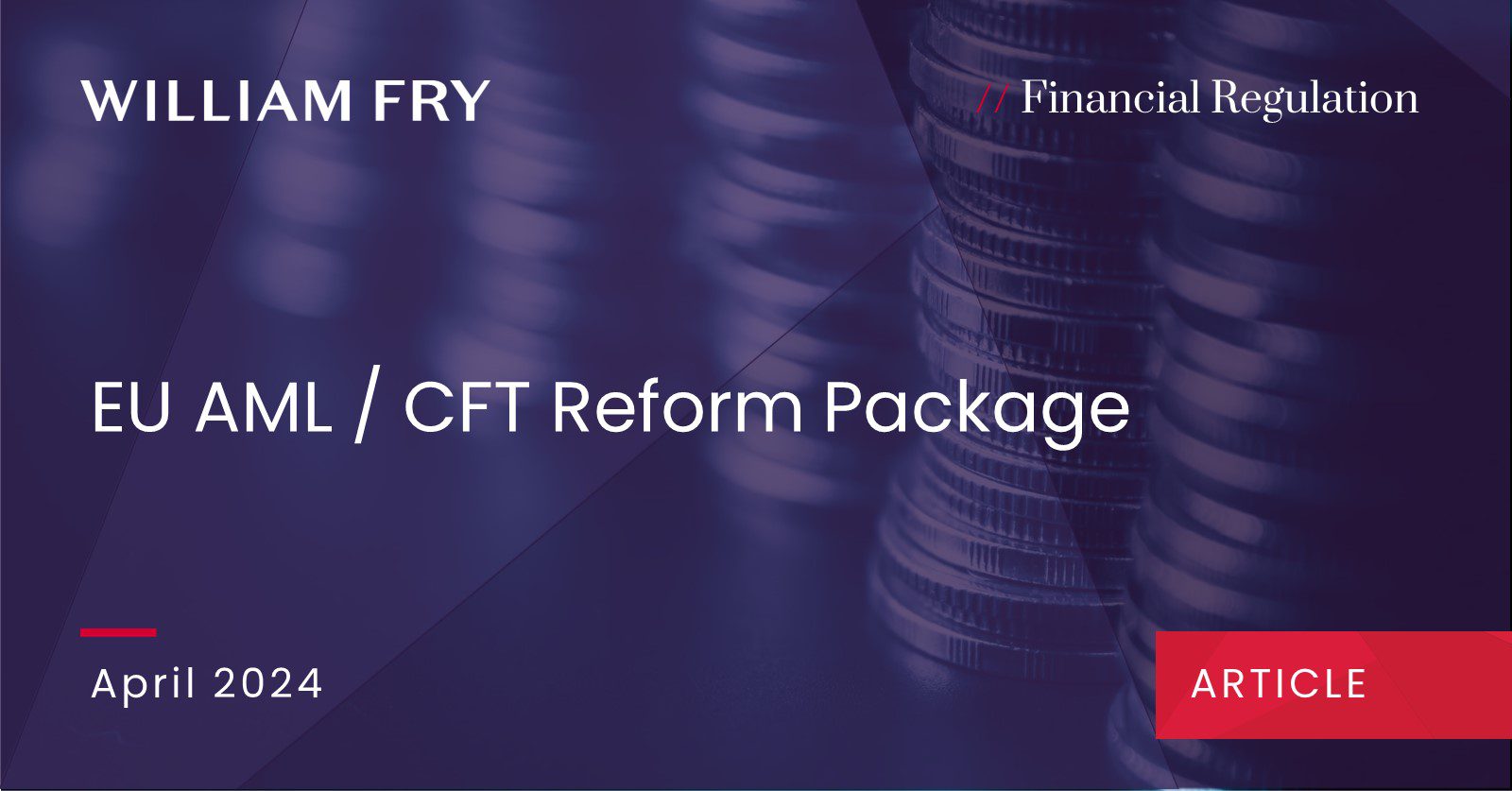The EU Parliament and the Council of the EU have provisionally agreed on the remaining elements of a package of anti-money laundering and countering the financing of terrorism measures (AML/CFT reform package), originally presented by the EU Commission in July 2021.
The key pieces of legislation in the original package comprise:
- AMLAR – the regulation on establishing a new EU AML and CFT Authority (AMLA) – text of AMLAR provisionally agreed on 13 December 2023.
- AMLR – the AML “single rulebook” regulation – text of AMLR provisionally agreed on 18 January 2024.
- AMLD6 – the sixth AML directive – text of AMLD6 provisionally agreed on 17 January 2024.
- Recast WTR – a recast revised wire transfer regulation ((EU) 2023/1113) – published in the EU’s Official Journal, in tandem with the Markets in Crypto Assets Regulation (MiCA), on 9 June 2023 to capture the transfer of crypto assets. The finalised Recast WTR text is available here.
The AML/CFT reform package will affect EU financial services providers and other obliged entities. Once published, related technical standards will provide further detail and clarity for financial firms including Crypto Asset Service Providers (CASPs), which will be subject to the new AML/CFT regime. Certain football clubs, traders in luxury goods, and exceptionally wealthy individuals may also be affected by these reforms.
Recent updates concerning the AML/CFT reform package include:
AMLAR
On 22 February 2024, the European Parliament and the Council of the EU announced that the seat of AMLA will be in Frankfurt. The agreement on the location of the AMLA seat was the last part of the negotiations on the EU Commission’s AML/CFT reform package requiring agreement.
Key features of AMLAR include:
-
Direct supervision of Selected Obliged Entities
A key feature of the AMLAR proposals includes the direct supervision of financial entities that pose the highest risk (Selected Obliged Entities) by AMLA.
Initially, up to 40 groups and financial entities in the EU (including CASPs as appropriate) will be chosen by AMLA, as Selected Obliged Entities, for direct supervision. The criteria for choosing the selected obliged entities have not yet been finalised.
Generally, Selected Obliged Entities will pose the highest risk of money laundering or terrorist financing and be active in at least six EU Member States. Selected Obliged Entities will include at least one institution from each EU Member State.
-
Indirect supervision of obliged entities and Supervisory Convergence
For obliged entities other than Selected Obliged Entities, AML/CFT supervision will remain at the Member State level. AMLA will have the power to settle disagreements between cross-border supervisory colleges. It is envisaged that AMLA will act as a central hub to coordinate the actions of supervisors in different EU countries and ensure the convergence of supervisory practices. It will also have a role in mediating and settling disputes between national authorities.
-
Financial Intelligence Units
AMLA will support Financial Intelligence Units (FIUs) in analysing suspicious transactions and detecting money laundering cases.
-
Rules and guidance
AMLA will have the general power to adopt technical standards. There will be new rules against circumvention of targeted financial sanctions and AMLA will have a supervisory role in ensuring implementation by obliged entities of targeted financial sanctions.
AMLR and AMLD6
The AMLR will provide detailed measures that banks and other entities must apply to protect the EU internal market from money laundering and terrorist financing. AMLD6 will provide for AML rules that are not included in AMLR and will require Member State transposition.
Key features of AMLR and AMLD6 include:
-
Obliged entities, scope expanded
The list of obliged entities will be expanded to include CASPs who will need to apply customer due diligence (CDD) measures when carrying out transactions amounting to €1000 or more, and other sectors including traders of luxury goods such as precious metals, precious stones, jewellers, horologists and goldsmiths.
From 2029, professional football clubs and agents (if they are involved in in-scope transactions) will be required to apply the same transparency rule but as the sector and its risk are subject to wide variations, Member States may exempt some less risky transactions (e.g. football clubs below the top league and with a yearly turnover of less than €5 million over two years) if they represent a low-risk.
Ultra-rich individuals (persons with a total wealth of at least €50 million excluding main residence) will qualify as having a higher risk profile as will those providing personalised wealth management services to them, such as banks and investment firms and funds. There will be a five million euro threshold for assets under management.
-
Due diligence
Specific enhanced due diligence (EDD) measures will be introduced for cross-border correspondent relationships for CASPs.
Obliged entities will have to undertake EDD measures in relation to occasional transactions and business relationships with high net-worth individuals that involve the handling of a large amount of assets. The failure to do so will be considered an aggravating factor in the sanctioning regime.
-
Beneficial ownerships
The content and functioning of the beneficial ownership registers will be further harmonised. Information on beneficial ownership will be available digitally in national central registers and through an interconnected system of registers at the EU level. It will include current and historical information for at least five years and no more than 10 years (plus an additional five years in the case of ongoing criminal investigations).
To detect money laundering schemes and freeze assets in time, national FIUs and other competent authorities will be able to access information on beneficial ownership held by obliged entities. The information on beneficial owners of certain foreign legal entities will also be in the beneficial ownership registers. This provision applies retroactively up to 10 years for real estate.
Beneficial ownership means having at least 25% of shares, or voting rights, or other direct or indirect ownership interest, calculated at every level of the value chain, as well as control or indirect control of an entity. This is in line with the position under the current AML regime. There had been discussions during the negotiation on the EU AML/CFT reform package that the beneficial ownership threshold would be lowered from 25% to 15% but this did not ultimately happen.
-
Cash payment limit of €10,000
There will be an EU-wide limit on large cash payments of €10,000 or more. This cash limit will be extended to payment services and electronic money providers. It will not apply to payments between natural persons who are not acting in a professional function.
-
Supervision
The powers and measures available to supervisors to ensure that obliged entities such as banks and other economic operators apply AML requirements will be strengthened and more stringent sanctions for entities breaching their AML obligations will be available.
-
Financial Intelligence Units
FIUs will have more power to analyse and detect money laundering and terrorist financing cases as well as to suspend suspicious transactions, accounts or business relationships. FIUs will share information between them and with competent authorities as well as cooperate with AMLA and other relevant EU bodies. As a key tool, they will be able to jointly analyse complex or cross-border cases, with AMLA.
FIUs and other national competent authorities will have access to information on beneficial ownership, bank accounts, land or real estate registers or certain high-value goods.
Recast WTR
On 16 May 2023, the EU Parliament and Council adopted updated rules on information accompanying the transfers of funds by extending the scope of the rules to transfers of crypto assets to strengthen financial transparency on exchanges in crypto assets and extend the EU AML/CFT framework to prevent their use for criminal purposes.
Under these rules, CASPs are obliged to collect and make accessible certain information about the sender and beneficiary of the transfers of crypto assets they operate, regardless of the amount of crypto assets being transacted. This ensures the traceability of crypto asset transfers to be able to better identify possible suspicious transactions and block them.
On 9 June 2023, the recast WTR was published in the EU’s Official Journal alongside MiCA. The Recast WTR will apply from 30 December 2024. For further information on MiCA, please see our recent articles here and here.
Next Steps
The agreed legislative measures (except recast WTR) remain to be formally approved by both the EU Parliament and Council and published in the EU’s Official Journal before they can enter into force. This is expected to happen in H1 2024.
Timelines
- AMLA is expected to be fully operational soonest. The authority is expected to finalise the list of selected obliged entities by the end of 2025 and to directly supervise selected obliged entities in 2026.
- AMLD6 will have to be transposed by Member States within two years following its entry into force.
- AMLR will apply three years after it enters into force (expected to be H1 2027).
Contact Us
For more information, please contact Louise McNabola, Shane Kelleher or your usual William Fry contact.
Contributed by Jane Balfe



